- This article is about the character class. For the Thunder Bluff guards, see hunter (guard). For the night elf occupation, see huntress.
Hunter | |
|---|---|
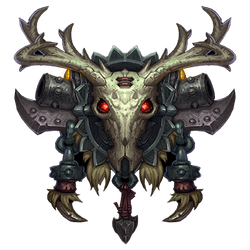 | |
| Available to |
|
| Specializations |
|
| Resource(s) | Focus |
| Primary attribute | Agility |
| Weapon skills | Bows, Guns, Crossbows, Polearms, Swords, Axes, Staves |
| Armor type | Mail; can also equip Leather, Cloth. |
| Signature abilities |
|
“The way of the hunter is one of mastery over the beasts of the world, an unparalleled precision in marksmanship, and the knowledge of how to survive in situations where others would perish.”
The hunter is a damage dealing class that can engage in either melee or ranged combat. Hunters who are master marksmen use a plethora of different shots to take down their prey, from venomous barbs and magical projectiles to explosive volleys and penetrating powershots, while those who focus on melee combat do so with polearms, executing deft flanking maneuvers and being particularly skilled at throwing their weapon. Hunters are also masters of survival, and their familiarity with traps and misdirection can allow them to manipulate their quarry's attentions, leading them into deadly ambushes or camouflaging themselves so well that even the sharpest-eyed of foes cannot fix their aim upon them. True to their name, hunters are also skilled huntsmen, capable of tracking even the stealthiest of targets with incredible accuracy.
Hunters have a powerful connection to the wild, and an uncanny ability to befriend even the wildest of beasts. Hunters form a deep bond with their pets, and are rarely to be found without a fierce companion at their side, ready to leap into battle at the hunter's command. Hunters can even call wild beasts and flocks of birds to assail their enemies, and in times of great need can summon a ![]() [Stampede] of faithful friends to their aid. Hunters do not use their pets only to deal ferocious damage to their foes, but can also draw strength and healing from their bond, regaining focus and inspiring their companions to surprising new heights. The powerful and intelligent animals commanded by hunters are themselves capable of a huge range of skilful and breath-taking moves, with each type of pet boasting its own selection of special abilities. Hunters are also capable of using their connection to the Aspects of various animals to empower themselves and their allies, augmenting their abilities according to the needs of the situation.
[Stampede] of faithful friends to their aid. Hunters do not use their pets only to deal ferocious damage to their foes, but can also draw strength and healing from their bond, regaining focus and inspiring their companions to surprising new heights. The powerful and intelligent animals commanded by hunters are themselves capable of a huge range of skilful and breath-taking moves, with each type of pet boasting its own selection of special abilities. Hunters are also capable of using their connection to the Aspects of various animals to empower themselves and their allies, augmenting their abilities according to the needs of the situation.
Hunters start wearing leather and advance to mail armor later on. They use agility and cunning to stay out of reach of melee attackers, commanding their pets to attack while they launch devastating volleys from afar. Hunters are at a disadvantage when their foes close in, and may use an array of traps and snares to slow and disorient attackers who threaten to draw too close for comfort. Hunters can also send their pets to taunt and distract enemies, overwhelming targets with a snarling attacker that demands their full attention, leaving them too busy to notice the deadly shot being carefully aimed at them.
Hunters expend focus for their most powerful abilities, while many others have no cost. Focus is capped at 100 (120 for Beast Mastery hunters) and regenerates slowly, but can also be regained through the use of numerous abilities. Hunter pets also use focus to fuel their most powerful attacks.
The hunter is a pure DPS class, meaning that all its specializations focus primarily on dealing damage. However, each type of hunter has its own strengths and priorities: Beast Mastery hunters are masters of the wild boasting a powerful synergy with their companions, bringing numerous enhancements to both their own and their pets' abilities; Marksmanship hunters are skilled sharpshooters, focusing on defeating opponents through unique and additionally empowered ranged attacks; Survival hunters are adaptive rangers who can engage enemies effectively at any distance, most effectively when up close.
Hunters are perhaps the most involved companion class of all. Hunters can track, tame, name and train a huge range of animals throughout the world, with a number of special rare beasts existing solely for hunters to discover, hidden from the eyes of any other class. Hunters will rarely find themselves fighting alone, and can count on the presence of their trusty companions at their side. The combination of hunters' powerful ranged damage capabilities and their pets' aggro management makes hunters an excellent soloing class, essentially a two-man team capable of tackling enemies far beyond the abilities of many other classes. A potent damage dealer with enviable abilities in kiting and crowd control, the hunter is a class that is easy to learn, but difficult to master.
Class overview[]
Game guide[]
From an early age the call of the wild draws some adventurers from the comfort of their homes into the unforgiving primal world outside. Those who endure become hunters. As masters of their environment, hunters are able to slip like ghosts through the trees and lay traps in the paths of their enemies. These expert marksmen drop foes dead in their tracks with flawless shots from a bow, crossbow or rifle. With the ability to wield two weapons simultaneously, hunters can unleash a flurry of blows against anyone unfortunate enough to stumble into close combat with them.
The art of survival is central to the isolated life of a hunter. Hunters track beasts with ease and enhance their own abilities by attuning themselves to the feral aspects of various creatures. Hunters are known for the lifelong bonds they form with animals of the wild, training great hawks, cats, bears, and many other beasts to fight alongside them.[1]
Creation screen description[]
Hunters know the uncharted places of the world. Gifted with a deep empathy for all life, they have an uncanny knack for befriending wild animals and taming them as pets. In addition, hunters can use their finely honed senses to become master trackers. Wherever hunters go, they fight back the ravages of sickness, exploitation, and industrialization. [2]
- Hunters are at home in the wilderness and have a special affinity for beasts. They rely on their weaponry and their pet to deal damage.
Classic guide[]
Drawn by the call of the wild, Hunters are survival experts whose skills are aided by their finesse with ranged weapons and kinship with fierce beasts.[3]
Background[]
- See also: Hunter races
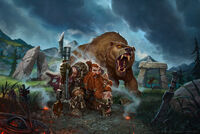
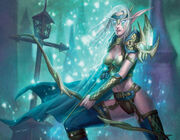
A night elf hunter.
The hunter is one of the oldest classes in history. They represent a deep connection between man and beast, and the hunters of Warcraft are not merely individuals who track animals and slay them for food, but custodians of balance. They understand the natural circle of life and death, and the part they must play in maintaining it not simply as researchers, but as active participants. The "Hunt" is venerated, and the prey they choose to stalk is given as much respect as the predators hunters choose to learn from and embody. All hunters create lifelong friendships with animal companions, who are also often their best and only friends, if the stereotype of the reclusive huntsman is to be believed.
Hunters come in all shapes, forms, sizes and specialties, but in World of Warcraft most hunters specialize to be marksmen (however, not all hunters choose the Marksmanship specialization). Hunters are a curious mix of mysticism and rough wilderness know-how. They can learn to mystically align themselves with the aspects of various animals to assist them: the tenacity of a turtle, the sharp eyes of an eagle, and the swiftness of a cheetah; they gift themselves with a higher resistance against the dangers of the most important thing of all in the rites of a hunter — the very Wilds he and his prey live in. Hunters also derive a system of hand-to-hand combat inspired by the attacks and counterattacks of various animals, and use magically empowered traps to maim and snare their prey. They have various shots imbued with magic or explosives to snare, poison, handicap and disorient their targets. They can even hold their breath and slow their heartbeat to a highly infrequent, inconsequential tap to give their pursuers the impression that they are dead.
The hunter is the choice of life for those who reject societies that oppress the natural role as prey and hunter, and also reject the druidic stance that we should be healers and observers rather than active participants in the "Great Hunt". They follow a life of reverence for nature complimenting their tradition and willingness to use man-made tools. We are all tool-using creatures after all, and it is only natural to use that advantage afforded by nature to be better hunters. There are however also those hunters who prefer a more direct approach to tracking and hunting.[citation needed]
Hunters are relentless in their pursuit of prey, whether they’re after beasts with more cunning than wit, dangerous monsters, or monstrous people—the deadliest quarry of all. But beyond their skills as survivalists, they’re students of what they hunt, observing abilities and tactics and using that knowledge to make themselves more dangerous and unpredictable foes.[4]
Notable[]
- See also: List of hunters
Races[]
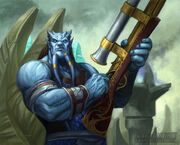
Marksman Boriz, a draenei hunter.
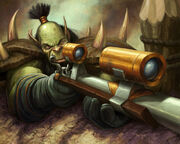
Scout Kurgo, an orc hunter.
- Main article: Hunter races
The hunter class can be played by all available races.
| Strength | Agility | Stamina | Intellect | Spirit | Armor | Health | Starting Pet | |||
|---|---|---|---|---|---|---|---|---|---|---|
| 21 | 20 | 21 | 20 | 23 | 40 | 56 | ||||
| 25 | 19 | 22 | 19 | 20 | 38 | 66 | ||||
| N/A | ||||||||||
| 20 | 23 | 21 | 20 | 21 | N/A | 56 | ||||
| 16 | 27 | 21 | 20 | 21 | 54 | 56 | ||||
| 23 | 25 | 21 | 16 | 20 | N/A | 56 | ||||
| N/A | ||||||||||
| N/A | ||||||||||
| N/A | ||||||||||
| N/A | ||||||||||
| N/A | ||||||||||
| 20 | 21 | 22 | 19 | 23 | 37 | 123 | ||||
| 17 | 25 | 21 | 23 | 19 | 50 | 56 | ||||
| 17 | 25 | 21 | 23 | 19 | 49 | 56 | ||||
| 23 | 20 | 22 | 17 | 23 | 40 | 66 | ||||
| 25 | 19 | 22 | 16 | 23 | 38 | 67 | ||||
| 21 | 25 | 21 | 16 | 22 | 50 | 56 | ||||
| 19 | 21 | 22 | 18 | 26 | N/A | 66 | ||||
| N/A | ||||||||||
| N/A | ||||||||||
| N/A | ||||||||||
| N/A | ||||||||||
| N/A | ||||||||||
Racial abilities[]
These are some relevant racial traits to hunters:

 Blood elves —
Blood elves —  [Arcane Torrent] provides an area of effect offensive dispel as well as restoring a small amount of focus.
[Arcane Torrent] provides an area of effect offensive dispel as well as restoring a small amount of focus.
 Draenei —
Draenei —  [Heroic Presence] increases your Strength, Agility, and Intellect by X (scales with level). Their
[Heroic Presence] increases your Strength, Agility, and Intellect by X (scales with level). Their  [Gift of the Naaru] ability also grants them a heal over time.
[Gift of the Naaru] ability also grants them a heal over time.
 Dwarves —
Dwarves —  [Might of the Mountain] Critical strike bonus damage and healing increased by 2%.
[Might of the Mountain] Critical strike bonus damage and healing increased by 2%.  [Stoneform] can help you mitigate DoT damage and physical damage for a short time.
[Stoneform] can help you mitigate DoT damage and physical damage for a short time.
 Gnome —
Gnome —  [Expansive Mind] gives 5% additional Focus, and
[Expansive Mind] gives 5% additional Focus, and  [Nimble Fingers] increases haste by 1%.
[Nimble Fingers] increases haste by 1%.
 Goblins —
Goblins —  [Time is Money] increases haste by 1%.
[Time is Money] increases haste by 1%.  [Rocket Barrage] sends a rocket towards the target, dealing fire damage which scales with level.
[Rocket Barrage] sends a rocket towards the target, dealing fire damage which scales with level.  [Rocket Jump] can be used to propel the Hunter forwards, the same distance as
[Rocket Jump] can be used to propel the Hunter forwards, the same distance as  [Disengage].
[Disengage].
 Humans —
Humans —  [Will to Survive] frees the hunter from CC effects, which is useful in most PvP and some PvE situations. It effectively frees up a trinket slot usually reserved for the same effect in PvP.
[Will to Survive] frees the hunter from CC effects, which is useful in most PvP and some PvE situations. It effectively frees up a trinket slot usually reserved for the same effect in PvP.  [The Human Spirit] gives players 2% more of all secondary stats from any source.
[The Human Spirit] gives players 2% more of all secondary stats from any source.
 Night elves —
Night elves —  [Touch of Elune] increases your haste by 1% during the night. Increases your Critical Strike by 1% during the day.
[Touch of Elune] increases your haste by 1% during the night. Increases your Critical Strike by 1% during the day.  [Shadowmeld] provides the hunter with a second aggro-dump (for when
[Shadowmeld] provides the hunter with a second aggro-dump (for when  [Feign Death] is resisted). Also allows the hunter to enter a stealth state (which breaks on movement) giving the hunter the ability to ambush opponents.
[Feign Death] is resisted). Also allows the hunter to enter a stealth state (which breaks on movement) giving the hunter the ability to ambush opponents.
 Orcs —
Orcs —  [Command] increases pet damage by 1%.
[Command] increases pet damage by 1%.  [Blood Fury] acts as an extra trinket (boosting your attack power).
[Blood Fury] acts as an extra trinket (boosting your attack power).
 Pandaren —
Pandaren —  [Epicurean] doubles the benefit of food buffs.
[Epicurean] doubles the benefit of food buffs.  [Quaking Palm] acts as a brief CC.
[Quaking Palm] acts as a brief CC.
 Trolls —
Trolls —  [Berserking] acts as an extra trinket (boosting your attack speed).
[Berserking] acts as an extra trinket (boosting your attack speed).  [Da Voodoo Shuffle] can be useful for kiting enemies.
[Da Voodoo Shuffle] can be useful for kiting enemies.  [Beast Slaying] allows you to level faster, and Hunters specialize in slaying beasts.
[Beast Slaying] allows you to level faster, and Hunters specialize in slaying beasts.
 Tauren —
Tauren —  [War Stomp] causes a short area-of-effect stun around the hunter, useful for getting out of melee range.
[War Stomp] causes a short area-of-effect stun around the hunter, useful for getting out of melee range.  [Brawn] increases critical strike damage.
[Brawn] increases critical strike damage.  [Endurance] increases Stamina, which grants a higher health pool.
[Endurance] increases Stamina, which grants a higher health pool.
 Undead —
Undead —  [Cannibalize] allows the hunter to heal in combat by consuming the corpse of a nearby humanoid or undead mob, though it must be channeled to gain the full benefit.
[Cannibalize] allows the hunter to heal in combat by consuming the corpse of a nearby humanoid or undead mob, though it must be channeled to gain the full benefit.  [Touch of the Grave] gives each attack a chance to deal some shadow damage to the target and heal the hunter for a similar amount.
[Touch of the Grave] gives each attack a chance to deal some shadow damage to the target and heal the hunter for a similar amount.  [Will of the Forsaken] frees the hunter from all Charm, Fear and Sleep effects, which is useful in nearly any situation.
[Will of the Forsaken] frees the hunter from all Charm, Fear and Sleep effects, which is useful in nearly any situation.
 Worgen —
Worgen —  [Viciousness] increases critical strike chance by 1%.
[Viciousness] increases critical strike chance by 1%.  [Darkflight] provides a very useful temporary speed boost, for those situations when running just isn't fast enough.
[Darkflight] provides a very useful temporary speed boost, for those situations when running just isn't fast enough.
Other racial attributes can also be useful, but may not be specifically relevant to hunters as a class. As always, research into all the racial traits of each race will make a player's decision better informed.
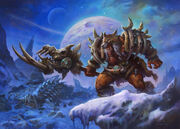
Fenris Wolfbrother, an orcish hunter.
Overview[]
- Hunters tame the wild beasts of Azeroth, training them to fight at their side. Hunters are one of five classes that can have controllable combat pets.[5] However, they are the only ones that can name their pets, and the only ones with a large variety of pets.
- Hunters excel in outdoor survival skills, such as tracking and laying traps.
- Hunters can wear cloth, leather and mail armor. They are unable to use shields or plate armor.
- Hunters can equip all weapons except wands, maces, two-handed maces, and warglaives.
- Hunters use many shots that either deal damage or apply a status effect that costs focus to use. Most other abilities are free to use such as
 [Mend Pet] or their Trap abilities.
[Mend Pet] or their Trap abilities. - Hunters can take on various Animal Aspects that grant special abilities, such as improved run speed.
Abilities[]
- For a full list of hunter abilities, see Hunter abilities.
Ranged fighting[]
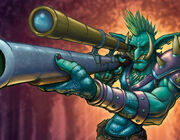
E'sad, a troll hunter
Ranged fighting requires a choice between a gun, bow, or a crossbow. When starting, this will depend on your race. Dwarves, goblins, tauren and worgen are given guns, draenei start with crossbows, and the other races get bows. Later on, you can train to use the ranged weapons that aren't inherent to your race. In general, crossbows are relatively slow, but hit harder and are favored for increasing burst damage, while guns are relatively fast and good for steady grinding. Bows have moderate attack speed and are favored for sustained DPS. Initially, weapon speed will be inconsequential since the only available abilities consist of Auto-Shot and various instant casts. Guns can be crafted by engineers, but there are no craftable bows or crossbows, so most ranged upgrades will come from mob drops and quest rewards. There are also a small amount of crafted weapons other than guns.
Stings and venoms[]
- Main article: Stings
Hunters have stings and venoms, which are specialized debuffs they can apply to targets to help them address specific situations. Most stings are PvP Talents, such as ![]() [Scorpid Sting] and
[Scorpid Sting] and ![]() [Viper Sting], and offer utility. Survival hunters have access to
[Viper Sting], and offer utility. Survival hunters have access to ![]() [Serpent Sting] as a base ability, which deals Nature damage over time to enemies.
[Serpent Sting] as a base ability, which deals Nature damage over time to enemies.
Shots[]
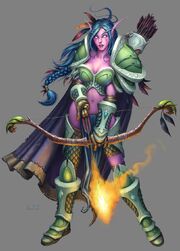
A night elf hunter.
Hunters also make heavy use of special shots to supplement their DPS and provide utility to their groups. The bulk of a hunter's damage and utility will come from the use of these shots.
Since patch 5.1.0, any shot, be it auto or cast-time, can be fired on the move, without any penalty. However, prior to Patch 3.0, the hunter could not move or fire their Auto Shot if they were casting another spell at the same time. The Auto Shot swing timer was still counting, but would not fire over another shot. This was called "clipping Auto Shot" and would greatly reduce DPS. This mechanic was at first countered with ![]() [Aspect of the Fox], and later removed entirely.
[Aspect of the Fox], and later removed entirely.
In the past, weapon speed was often critical to maximizing DPS output, but the standardization of weapon speeds and disuse of shot rotations means that hunters should now simply use the weapon with the best DPS and stats, regardless of speed. Previously, due to clipping consideration, weapon speed was crucial to maximizing DPS with shot rotation, and a hunter would aim to choose a ranged weapon of an appropriate speed (2.7 for beast masters, 3-3.1 for survivalists and marksmen) to fit neatly between the cooldowns of their more powerful abilities. These days, however, all weapons have the same speed, and since shot rotations are not used, speed is no longer important.
Melee combat[]
Survival Hunters revolve completely around close-range combat, abandoning a bow, crossbow, or gun in favor of a melee weapon, such as a Spear or Axe. Survival Hunters fight in the thick of melee combat alongside their animal pet, tearing bleeding wounds in their foes and laying traps beneath their feet. The hunter emulates animals in some of their attacks, such as ![]() [Raptor Strike] and Mongoose Bite.
[Raptor Strike] and Mongoose Bite.
By coordinating their efforts, the hunter and the beast execute deft flanking strikes, dealing high damage while the other has the enemy's attention. The hunter is also unique among melee classes in that they have access to a plethora of ranged utility. Many of their abilities include throwing attacks, such as ![]() [Wildfire Bomb] and
[Wildfire Bomb] and ![]() [Harpoon], and they throw their traps from range like the other two Hunter specs. This means that a Survival Hunter is dangerous from range, and even more dangerous up close.
[Harpoon], and they throw their traps from range like the other two Hunter specs. This means that a Survival Hunter is dangerous from range, and even more dangerous up close.
Combat pets[]
- Main article: Hunter pet
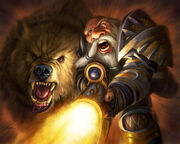
A dwarf hunter and his pet bear.
Pets are the most important tools in the hands of a hunter. They serve as aggro-management, additional DPS, and as tanks. The pet is essential to all specs, dealing anywhere from 10% of total damage for a marksman to 50% for a beast master. Formerly, pets had anemic damage potential and weak AI that often made them more of a danger to a raid than an asset. But improved AI - pets now always attack from the back of a monster - and an innate 90% damage avoidance has made this no longer a concern.
Many beast-type mobs can be tamed, and each offer a set of unique active skills (there are special abilities just for wolves, just for cats, etc). In addition, certain pet types are tanking-oriented (such as bears and turtles), and others are DPS-oriented (such as cats and owls). Combined with the diversity of armor, stamina and resistance buffs, pets are allowed a great deal of customization. Many hunters have dedicated pets for specific instances, PvP, tanking, and so on.
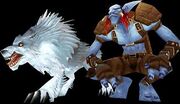
A troll hunter and his white wolf.
Hunters start with a pet at level 1 and can ![]() [Tame Beast] pets at level 10. They are able to control the pet through various commands. Although hunters can have only one active pet at a time, they have immediate access to 4 additional pets using
[Tame Beast] pets at level 10. They are able to control the pet through various commands. Although hunters can have only one active pet at a time, they have immediate access to 4 additional pets using ![]() [Call Pet] and they can house up to 20 pets in the stable.
[Call Pet] and they can house up to 20 pets in the stable.
In addition to regular animals, a number of special targets have been introduced into the game world specifically for hunters to track and tame. These beasts present a Taming Challenge and require special tactics to ready them for taming, much like the original epic bow quest in Vanilla World of Warcraft. While some of these are simply hard to find (and even harder to tame), those introduced in Mists of Pandaria are fully invisible beasts, able to be revealed only by hunters using ![]() [Flare], who must first find them by seeking out their subtle and elusive tracks. See Taming Challenge for a list.
[Flare], who must first find them by seeking out their subtle and elusive tracks. See Taming Challenge for a list.
Traps[]
- Main article: Hunter trap
Hunters have access to a unique mechanic - traps. Traps exist in two main types; ![]() [Freezing Trap], which freezes an enemy in place, and
[Freezing Trap], which freezes an enemy in place, and ![]() [Tar Trap], which lays an oil slick upon the ground.
[Tar Trap], which lays an oil slick upon the ground.
Through talents, more Traps can be accessed: Hi-Explosive Trap deals light Fire damage and knocks enemies away; for Survival Hunters, ![]() [Steel Trap] roots an enemy in place and deals heavy damage over time.
[Steel Trap] roots an enemy in place and deals heavy damage over time.
Aspects[]
- Main article: Animal Aspects
Amongst many different aspects, two main variants remained in game.
Damage increasing Aspects:
 [Aspect of the Eagle] grants Survival Hunters the ability to use Raptor Strike or Mongoose Bite from 40 yards away, morphing them to a fully ranged class for 20 seconds.
[Aspect of the Eagle] grants Survival Hunters the ability to use Raptor Strike or Mongoose Bite from 40 yards away, morphing them to a fully ranged class for 20 seconds. [Aspect of the Wild] grants Beast Mastery Hunters extra Critical Strike chance and Focus per second.
[Aspect of the Wild] grants Beast Mastery Hunters extra Critical Strike chance and Focus per second.
Speed increasing Aspects:
 [Aspect of the Cheetah]: The hunter takes on the characteristics of a cheetah, sprinting for 90% movement speed for 3 seconds, before 'jogging' for 30% increased speed for 6 seconds.
[Aspect of the Cheetah]: The hunter takes on the characteristics of a cheetah, sprinting for 90% movement speed for 3 seconds, before 'jogging' for 30% increased speed for 6 seconds.
Utility Aspects:
 [Aspect of the Turtle] has the Hunter enter a defensive stance, blocking all damage but making them unable to attack.
[Aspect of the Turtle] has the Hunter enter a defensive stance, blocking all damage but making them unable to attack.
and
 [Aspect of the Beast] returns as
[Aspect of the Beast] returns as  [Aspect of the Chameleon], but only retains the untrackable part.
[Aspect of the Chameleon], but only retains the untrackable part.
Tracking[]
Hunters are the only class that can track any type of creature individually, or simultaneously over the minimap.
Specializations[]
- For a list of abilities and talents by specialization, see Hunter abilities.
- "Beast Master" redirects here. For the talent, see
 [Beast Master]. For the artifact trait, see
[Beast Master]. For the artifact trait, see  [Beast Master].
[Beast Master].
Beast Mastery[]
A master of the wild who can tame a wide variety of beasts to assist <him/her> in combat.
While all hunters value the assistance of their animal companions, Beast Mastery hunters have the closest bonds of all with their pets. Beast Mastery (BM) hunters place far more importance on the pet, dealing an increased amount of damage through the addition of numerous active and passive abilities, as well as through their mastery ![]() [Mastery: Master of Beasts]. The pets of BM hunters deal more damage, regenerate focus more quickly, can use their special attacks more often and benefit from bonus crits, splash damage and haste procs. BM hunters and their pets have the most focus of any hunters, with their animal bond contributing
[Mastery: Master of Beasts]. The pets of BM hunters deal more damage, regenerate focus more quickly, can use their special attacks more often and benefit from bonus crits, splash damage and haste procs. BM hunters and their pets have the most focus of any hunters, with their animal bond contributing ![]() [Invigoration] to both parties. BM hunters are also the only hunters sufficiently attuned to the animal kingdom to be capable of taming
[Invigoration] to both parties. BM hunters are also the only hunters sufficiently attuned to the animal kingdom to be capable of taming ![]() [Exotic Beasts], allowing them to gain some of the most impressive and exciting pets in the game.
[Exotic Beasts], allowing them to gain some of the most impressive and exciting pets in the game.
Among the most gifted hunters, there are those who have from birth felt a profound bond with the creatures of the wild. These beast masters are drawn to the perilous primal world, invigorated by its dangerous and untamed nature. Primitive landscape becomes home. Ferocious predator becomes kin. Whether in the thrill of the hunt or the heat of battle, beast masters call forth a litany of vicious animals to overwhelm prey and gnaw at their enemies’ will.[6]
Marksmanship[]
A master archer or sharpshooter who excels in bringing down enemies from afar.
Masters of ranged weaponry, Marksmanship hunters focus on honing their skills with the gun or bow. The standard hunter's repertoire of shots is significantly improved for Marksmanship hunters, with new types of shots and additional effects added to others. The powerful Marksmanship abilities ![]() [Aimed Shot] and
[Aimed Shot] and ![]() [Chimaera Shot] are augmented along with
[Chimaera Shot] are augmented along with ![]() [Steady Shot] and
[Steady Shot] and ![]() [Multi-Shot] to build to a devastating synergy of ranged attacks, dealing swift and explosive damage while granting disorients, bleeds and even self-healing. Marksmanship hunters' potent damage output is increased by their mastery
[Multi-Shot] to build to a devastating synergy of ranged attacks, dealing swift and explosive damage while granting disorients, bleeds and even self-healing. Marksmanship hunters' potent damage output is increased by their mastery ![]() [Mastery: Sniper Training], increasing their damage, range, and critical strike damage when they stand still for 3 seconds.
[Mastery: Sniper Training], increasing their damage, range, and critical strike damage when they stand still for 3 seconds.
Marksmen, too, shroud themselves in the perils of the untamed wilds, perfecting the use of weapons that are deadliest from great range. They’ve maintained little interest, however, in gaining the loyalty of the many beasts inhabiting these crude landscapes. Instead, the marksman blends into the surrounding environment, surveying behavior of all manner of predator and gleaning deadly methods for stalking their own prey. A sniper in hiding, the marksman unleashes arrows and bullets with deadly precision, exposing the weakness in whoever—or whatever—passes through their crosshairs.[6]
Survival[]
A rugged tracker who favors using animal venom, explosives and traps as deadly weapons.
Survival Hunters focus on the chaos of melee combat, fighting fang and claw alongside a loyal friend. Through peerless mastery of a spear, Survival Hunters are able to subsist in environments where others would fail, wielding only a blade and a pet. They slip traps under enemy's feet in melee combat, and use their weapon to tear bleeding holes in their enemies. Together, the Survivalist and the pet coordinate their attacks to flank the foe while one has their attention. With powerful Mongoose Bites, Survival Hunters ramp their damage up to terrifying numbers, which are only strengthened further by their mastery, ![]() [Mastery: Hunting Companion].
[Mastery: Hunting Companion].
While all hunters feel a calling to the wild, some serve as a reflection of its brutality. To them, the hunt is defined by unrelenting ferocity, where survival means facing one’s enemy eye-to-eye . . . and is always accompanied by merciless bloodshed. Weapons of great range are abandoned for instruments of close-quarters combat. Survival hunters are instinctive and crafty on the prowl, employing loyal beasts and laying deceptive traps to see their enemies undone. For these hunters know that to truly understand what it means to survive, one must first become familiar with the cruel face of death.[6]
Pet specializations[]
- See also: Pet abilities
Each pet family comes with a default specialization. Each specialization deals the same amount of damage, but grants the Hunter different utility depending on the specialization.
Cunning[]
Guileful creatures capable of skillfully mitigating lethal blows dealt to themselves and their allies.
Cunning pets are focused on mobility. They have a constant passive called Pathfinder, which grants the Hunter and pet 8% increased Movement Speed, and they come with the active ability ![]() [Master's Call], which liberates a target of all roots and slows, and makes them immune to roots and slows for a short period.
[Master's Call], which liberates a target of all roots and slows, and makes them immune to roots and slows for a short period.
Ferocity[]
- "Ferocity" redirects here. For other uses, see Ferocity (disambiguation).
Driven by a frenzied persistence to pursue prey, these beasts stop at nothing to achieve victory; even death is temporary for these predators.
Ferocity pets are focused on consistent damage. They don't deal more DPS themselves than Cunning or Tenacity pets, but they grant the Hunter access to ![]() [Primal Rage], a Bloodlust/Heroism ability that grants all members of the party or raid 30% increased Attack Speed for 40 seconds. They also have the passive Predator's Thirst, which grants the Hunter and Pet 10% Leech, causing them to heal for 10% of all damage they deal.
[Primal Rage], a Bloodlust/Heroism ability that grants all members of the party or raid 30% increased Attack Speed for 40 seconds. They also have the passive Predator's Thirst, which grants the Hunter and Pet 10% Leech, causing them to heal for 10% of all damage they deal.
Tenacity[]
Stalwart and veteran defenders who unquestionably place their thick hides and protective exteriors in harm's way for their allies.
Tenacity pets increase the pair's durability. They sport the passive Endurance Training, which grants Hunter and Pet 5% increased maximum Health. They also come with the active ability ![]() [Survival of the Fittest], which reduces damage taken by the Hunter and Pet by 20% for 6 seconds.
[Survival of the Fittest], which reduces damage taken by the Hunter and Pet by 20% for 6 seconds.
Gear[]
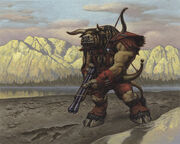
Kalnuf Eagleheart, a tauren hunter.
Armor[]
Hunters can initially only wear cloth and leather, but at level 40 are able to equip mail, with the level 50 ![]() [Mail Specialization] rewarding them for doing so. See hunter sets for a list of hunter armor sets.
[Mail Specialization] rewarding them for doing so. See hunter sets for a list of hunter armor sets.
During the early beta days of World of Warcraft, hunters could wear bucklers.
Weapons[]
Hunters can use bows, guns, and crossbows. Usable melee weapons are Polearms and Staves; they can also wield Swords, Axes, Daggers, and Fist Weapons, but cannot use one-handed variants with abilities and only benefit from weapons with Agility, most commonly found on Polearms and Staves. Marksmanship and Beast Mastery Hunters shun melee weapons, and are useless when they have them equipped. Survival Hunters embrace melee weapons and shun ranged ones instead.
Upon reaching level 20, hunters can learn the Dual Wield skill. This allows them to wield two one-handed weapons at the same time. This is a legacy ability from days when Dual Wielding was a viable trait for Hunters. They retain the ability, but Survival is focused entirely on two-handed Polearms and Staves.
Before Mists of Pandaria, hunters could equip melee weapons at the same time as their ranged weapons. Polearms were generally considered the best melee weapon for hunters, due to disinterest from other classes, slow attack speed, and stats that could be utilized for ranged abilities. Also, polearms tended to have stats for hunters, like Agility, where two-handed swords or axes mostly have Strength. The slow attack speed ensured that the few swings the hunter may have to make maximized the damage possible for each swing. Another factor was looks, as the melee weapon was the only weapon that would regularly show on the hunter, while the ranged weapon would only show up while in use. Prior to Cataclysm, hunters were able to wield thrown items, and in the beta even had shields.
Today, unless you're Survival, there is no reason for hunters to roll on melee weapons available for their level. However, there is a wide variety of older content from earlier expansions that a hunter can solo for other purposes: the prime example would be ![]() [Hydrocane] for water breathing. This can then be transmogrified to any two-handed weapon such as an old hunter polearm, or a two-handed sword or axe, like Gorehowl. If one does Dual Wield, this opens up roleplaying possibilities such as matching daggers, two
[Hydrocane] for water breathing. This can then be transmogrified to any two-handed weapon such as an old hunter polearm, or a two-handed sword or axe, like Gorehowl. If one does Dual Wield, this opens up roleplaying possibilities such as matching daggers, two ![]() [Dragonscale-Encrusted Longblade], or fist weapon sets.
[Dragonscale-Encrusted Longblade], or fist weapon sets.
Attribute conversions[]
In modern World of Warcraft, most attributes are affected by Diminishing Returns, making it impossible to assign absolute values to each attribute. The general priority of importance however, can be assumed below.
- Weapon DPS: The damage displayed on a weapon.
- Agility: Increases attack power and critical strike rating with ranged weapons. 1 Agility = 2 Attack Power
- Versatility: Provides increased damage and healing, while also reducing damage taken for a lesser amount.
- Critical strike: Doubles the player's attack if successful. A theoretical 104.7% are needed to cap this stat.
- Haste: Increases the amount of auto shots/auto attacks, focus regained and pet focus regained.
- Mastery: Increases your damage depending on your specialization via:
 [Mastery: Master of Beasts],
[Mastery: Master of Beasts],  [Mastery: Sniper Training], or
[Mastery: Sniper Training], or  [Mastery: Spirit Bond]
[Mastery: Spirit Bond]
End-game expectations[]
General[]
A hunter's primary responsibility in nearly all raid encounters is to sustainably generate high DPS. Hunters should be using ![]() [Misdirection] on the main tank (unless told otherwise) at the start of the fight, ensuring that the main tank gets the initial aggro of the pull and the boss doesn't one-shot one of the melee standing close by. They will also need to monitor their focus usage and regen using
[Misdirection] on the main tank (unless told otherwise) at the start of the fight, ensuring that the main tank gets the initial aggro of the pull and the boss doesn't one-shot one of the melee standing close by. They will also need to monitor their focus usage and regen using ![]() [Steady Shot],
[Steady Shot], ![]() [Barbed Shot], or
[Barbed Shot], or ![]() [Kill Command], depending on their Spec or talent usage.
Your primary role is to deal DPS, as much as possible. In order to do this, make sure all your gear is enchanted and gemmed accordingly to your Spec, make sure you have your pet out, and that it's not on passive (If you aren't using
[Kill Command], depending on their Spec or talent usage.
Your primary role is to deal DPS, as much as possible. In order to do this, make sure all your gear is enchanted and gemmed accordingly to your Spec, make sure you have your pet out, and that it's not on passive (If you aren't using ![]() [Lone Wolf]), make sure you choose the talents that bring you the most DPS. Make sure you have a flask/double elixir on and make sure you use a Potion (Agility is optimal) 1-2 seconds before the pull. This will give you the option to use another potion during the fight, preferably when your DPS cooldowns come back off cooldown. Also note that you can negate some boss abilities completely with
[Lone Wolf]), make sure you choose the talents that bring you the most DPS. Make sure you have a flask/double elixir on and make sure you use a Potion (Agility is optimal) 1-2 seconds before the pull. This will give you the option to use another potion during the fight, preferably when your DPS cooldowns come back off cooldown. Also note that you can negate some boss abilities completely with ![]() [Aspect of the Turtle],
[Aspect of the Turtle], ![]() [Disengage] and
[Disengage] and ![]() [Feign Death]. In order to know what abilities you can avoid or negate, you will have to experiment yourself during the encounters themselves, or ask on one of the many forums for WoW!
[Feign Death]. In order to know what abilities you can avoid or negate, you will have to experiment yourself during the encounters themselves, or ask on one of the many forums for WoW!
Focus Management[]
The most important thing that many new or returning hunters miss is Focus Management. You start off at 100 focus (120 for BM), your ![]() [Steady Shot], Barbed Shot, or
[Steady Shot], Barbed Shot, or ![]() [Kill Command] regenerate focus when casted, and the majority of other spells cost Focus to be used.
If a big and important spell is coming off cooldown in the next ~3 seconds, you have to "pool" your focus above the spells cost to make sure you can cast it INSTANTLY when it comes off cooldown. If you have too much focus, use so called "focus dump" abilities to get rid of excess focus, such as
[Kill Command] regenerate focus when casted, and the majority of other spells cost Focus to be used.
If a big and important spell is coming off cooldown in the next ~3 seconds, you have to "pool" your focus above the spells cost to make sure you can cast it INSTANTLY when it comes off cooldown. If you have too much focus, use so called "focus dump" abilities to get rid of excess focus, such as ![]() [Arcane Shot],
[Arcane Shot], ![]() [Cobra Shot], or
[Cobra Shot], or ![]() [Raptor Strike]. Try to never be focus capped (Spam too much Focus Generators) and never miss an important ability because your focus was low.
If you have trouble with focus management, try taking talents that shore up your weaknesses. If you end up Focus capping too often, take talents that spend your Focus. If you end up without enough Focus to use abilities, take talents that boost Focus regeneration. As with everything else, focus management takes time and practice, and it's an essential part of the class since implemented in the Cataclysm Expansion and every hunter worth his spear should know how to do it properly!
[Raptor Strike]. Try to never be focus capped (Spam too much Focus Generators) and never miss an important ability because your focus was low.
If you have trouble with focus management, try taking talents that shore up your weaknesses. If you end up Focus capping too often, take talents that spend your Focus. If you end up without enough Focus to use abilities, take talents that boost Focus regeneration. As with everything else, focus management takes time and practice, and it's an essential part of the class since implemented in the Cataclysm Expansion and every hunter worth his spear should know how to do it properly!
Trapping in Raids and Dungeons[]
You will almost never be asked to trap during raids, but you might be asked during 5man groups and heroics. Trapping is a form of Crowd Control.
This is typically done by using ![]() [Freezing Trap] at the target to control a single target, or
[Freezing Trap] at the target to control a single target, or ![]() [Tar Trap] to control a group. During raid encounters that feature lots of adds, or additional enemies, Tar Trap can be used to slow their approach and give your ranged allies and yourself more time to damage them before they reach their targets. If you play Survival and opt into the
[Tar Trap] to control a group. During raid encounters that feature lots of adds, or additional enemies, Tar Trap can be used to slow their approach and give your ranged allies and yourself more time to damage them before they reach their targets. If you play Survival and opt into the ![]() [Steel Trap] talent, it should be used on cooldown as a DPS ability. Using an @cursor macro to make traps instantly cast at your cursor makes the ability much more fluid to use. An example of this macro, for Steel Trap (it functions with any traps, just replaced 'Steel Trap' for one of the others), is as follows:
[Steel Trap] talent, it should be used on cooldown as a DPS ability. Using an @cursor macro to make traps instantly cast at your cursor makes the ability much more fluid to use. An example of this macro, for Steel Trap (it functions with any traps, just replaced 'Steel Trap' for one of the others), is as follows:
#showtooltip Steel Trap
/cast [@cursor] Steel Trap
Kiting[]
In some cases you will be asked to Kite one or more creatures that either cannot or should not be killed during a specific encounter, allowing the rest of the raid to focus on other needs in order defeat the objective. Kiting is a skill that is best accomplished by hunters (even melee Hunters!), because they are intrinsically designed to be good kiters. If there is just one enemy, use ![]() [Concussive Shot] or
[Concussive Shot] or ![]() [Wing Clip] to slow them down. If you're kiting a pack of mobs, consider using
[Wing Clip] to slow them down. If you're kiting a pack of mobs, consider using ![]() [Tar Trap] to slow them all down. If the target is vulnerable to stuns or roots, abilities like
[Tar Trap] to slow them all down. If the target is vulnerable to stuns or roots, abilities like ![]() [Intimidation] and
[Intimidation] and ![]() [Binding Shot] can be lifesavers. If they get close to you,
[Binding Shot] can be lifesavers. If they get close to you, ![]() [Aspect of the Cheetah] and
[Aspect of the Cheetah] and ![]() [Disengage] can make some distance, and if they reach you,
[Disengage] can make some distance, and if they reach you, ![]() [Aspect of the Turtle] will keep you from being damaged. Consider using a Cunning-specialized pet, granting you the bonus Movement Speed offered by their Pathfinder passive. Certain pets, such as a Crocolisk, also have access to targeted slows. If you're playing as the melee-Survival Hunter, using
[Aspect of the Turtle] will keep you from being damaged. Consider using a Cunning-specialized pet, granting you the bonus Movement Speed offered by their Pathfinder passive. Certain pets, such as a Crocolisk, also have access to targeted slows. If you're playing as the melee-Survival Hunter, using ![]() [Aspect of the Eagle] to boost your range will allow you to keep your DPS up on the target, even while at range. If it's not available, you can use
[Aspect of the Eagle] to boost your range will allow you to keep your DPS up on the target, even while at range. If it's not available, you can use ![]() [Harpoon] to root the target, strike them with a melee ability or two, and then run out to kiting range again. If, for any reason, you need to lose aggro and cease kiting, use
[Harpoon] to root the target, strike them with a melee ability or two, and then run out to kiting range again. If, for any reason, you need to lose aggro and cease kiting, use ![]() [Feign Death] to make the target stop following you. Kiting, for most hunters, is the hardest skill to learn, yet is considered by many to be the most important skill.
[Feign Death] to make the target stop following you. Kiting, for most hunters, is the hardest skill to learn, yet is considered by many to be the most important skill.
PvP[]
Hunters wishing to participate in end-game PvP will find any of the specializations help them towards their goals of massive player destruction!
The Beast Mastery Hunters can employ their powerful pets to damage and hound enemies even when the Hunter is safe beyond range or behind cover. Abilities that summon additional beasts, such as Dire Beast, can end up overwhelming enemies with many targets. This often causes players to panic, and attempt to run, use AoE-focused CC on the pets, or use preventative defensive cooldowns. This specialization requires masterful management of your pet's movement: you don't want to get ambushed only to find your pet is busy gnawing on a Druid you sent it after 30 seconds ago, unable to assist you.
Marksmanship Hunters benefit from having some of the highest range, and highest burst, of any class. Take advantage of the superior range granted by ![]() [Mastery: Sniper Training] to dance just out of range of enemy abilities, or assault them from atop hills or towers where they cannot immediately reach you. Always enter an encounter with a full Focus-bar, so that you have plenty of Focus to spend on your high-damage
[Mastery: Sniper Training] to dance just out of range of enemy abilities, or assault them from atop hills or towers where they cannot immediately reach you. Always enter an encounter with a full Focus-bar, so that you have plenty of Focus to spend on your high-damage ![]() [Aimed Shot].
[Aimed Shot].
The Survival Hunter is the most versatile of the specs, able to dish out damage from any range. They can mix it up with melee classes, and also take down enemy ranged casters. Pet management is important, although not as important as Beast Mastery: the Hunter relies on their pet for Focus regeneration, and you need it close by to use your most damaging abilities. While a melee spec, ranged combat is still a large focus, and learning to properly kite while using your ranged ![]() [Serpent Sting], Wildfire Bomb, and
[Serpent Sting], Wildfire Bomb, and ![]() [Kill Command] are essential lessons to learn.
[Kill Command] are essential lessons to learn.
Some skills are universal, no matter the specialization. Using ![]() [Tar Trap] to slow enemies in chokepoints can be a valuable asset to your PvP team. Your Tracking abilities get much more use here than in PvE, and you can smell characters attempting to hide in ambush around walls and either enter prepared or find a different route. Hunters particularly excel at finding stealthed enemies. Your
[Tar Trap] to slow enemies in chokepoints can be a valuable asset to your PvP team. Your Tracking abilities get much more use here than in PvE, and you can smell characters attempting to hide in ambush around walls and either enter prepared or find a different route. Hunters particularly excel at finding stealthed enemies. Your ![]() [Flare] is an important tool for revealing enemy stealthed Rogues, Druids, or even enemy Hunters. Remember to keep
[Flare] is an important tool for revealing enemy stealthed Rogues, Druids, or even enemy Hunters. Remember to keep ![]() [Track Hidden] active at all times so you can spot stealthed enemies your allies might miss. If you know the enemy has a Hunter or Feral Druid that can track you, using
[Track Hidden] active at all times so you can spot stealthed enemies your allies might miss. If you know the enemy has a Hunter or Feral Druid that can track you, using ![]() [Aspect of the Chameleon] will grant you the element of surprise.
[Aspect of the Chameleon] will grant you the element of surprise.
Hunters excel at taking out soft targets like warlocks, priests, and mages from a distance, and should do so before moving on to hard targets such as warriors and paladins, though if a rogue is observed, it is the hunter who is best equipped to track and expose the rogue by marking him with ![]() [Flare]. Hunter's pets can also break an unseen rogue's stealth if he is close and you order to follow them and attack.
[Flare]. Hunter's pets can also break an unseen rogue's stealth if he is close and you order to follow them and attack.
In the RPG[]
The hunter is a stalker in the wilds, living on his knowledge of survival and skill with a bow or rifle. He is deeply in tune with nature, and some of its mightiest beasts are his allies. Of Azeroth's many creatures, few can resist the hunter's call, and fewer can survive his fury. Hunters are as varied as the world's many climates, but they are universally renowned for their amazing abilities to find their prey and bring it down. They come from any race (players are restricted to twelve races, see below), though certain races naturally excel at the hunter's profession. Most hunters seek to aid the balance of nature along with their druidic allies.[7] Elven rangers are not alone in their mastery of the wilderness. While an elven ranger prefers the bow, the hunter would rather get up close. A hunter is skilled in stealth, slipping through the woods like a ghost. Orcs of the Horde first learned the ways of the hunter from forest trolls on Lordaeron and tauren have been masters of the hunt since the dawn of the world. Like the shamans of the Horde, hunters call upon the spirits of the land, wind, and fire to aid them in their hunts and tasks. Their spells focus on the elements and the land.[8]
Notes and trivia[]
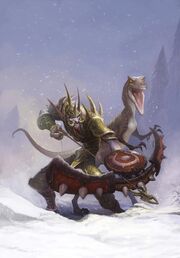
- Hunters are the most played class according to Warcraft Realms as of 2015 at 15% of characters created being hunters.
- The "OMG HUNTER LOOT" / "That's a hunter weapon!" joke is derived from a time when some classes carried a ranged weapon and a melee weapon. Prior to the Cataclysm expansion, hunters could dual-wield daggers, axes, and swords as well as equip two-handed swords, polearms, axes, and staves as 'stat sticks'. Warriors and Rogues could equip ranged weapons, leading to hunters laying claim on many items and vice-versa. As noted, though, the joke lacks relevance as ranged weapons have been limited to guns, crossbows, and bows and are only usable by hunters. Weapons can no longer be used in this way, and itemization of both ranged and melee types reflects these changes.
- While the hunter is an easy class to play at a superficial level, it can be a highly challenging class to play well. People will consistently tell you that damage is the only reason for a hunter's existence; in raids, and possibly in soloing, that might be true, but in five man instances and battleground PvP in particular, it isn't. You can use traps as a form of crowd control, and you need to monitor your pet to ensure that it does not cause problems.
- In addition, in most MMORPGs, the hunter or ranger class variant is usually recognized as the ideal ranged puller in a group. World of Warcraft is somewhat unique in that within its culture, ranged pulling is generally not considered a hunter's responsibility, to the point where hunters in groups will actually be expressly forbidden from doing so. This is true despite the fact that, as with other games, in WoW Blizzard has equipped the hunter with numerous unique abilities (Disengage, Feign Death, Tracking) to assist them in the accomplishment of that task. The advent of
 [Misdirection] has changed this a bit, with tanks often requesting that a hunter "MD that mob to me." In combat, hunters have the ability to quickly remove all threat they have generated on a target via
[Misdirection] has changed this a bit, with tanks often requesting that a hunter "MD that mob to me." In combat, hunters have the ability to quickly remove all threat they have generated on a target via  [Feign Death]. This ability does not remove you from combat when fighting raid bosses.
[Feign Death]. This ability does not remove you from combat when fighting raid bosses. - Before Legion, Survival was a mostly ranged DPS spec, like Beast Mastery and Marksmanship. However, in beta and early classic WoW, Survival (originally named Outdoormanship) hunters were in fact intended to engage mostly in melee, and had many talents to support this. Even in later versions, Survival hunters retained melee abilities such as
 [Mongoose Bite] and
[Mongoose Bite] and  [Counterattack], until being reworked into a proper melee spec as they were intended to be originally.
[Counterattack], until being reworked into a proper melee spec as they were intended to be originally. - With the addition of gnome hunters in World of Warcraft: Legion, hunters will become the second class available to all thirteen playable races (the first one being warrior).
- The hunter prestige class was replaced with the hunter core class in the World of Warcraft RPG.[9]
- Hunter was the last class to be added during development of World of Warcraft and barely made it in. Because of this, the class's design at the time of launch was "pretty much" the same as the earliest designs for it.[10]
Gallery[]
Hemet Nesingwary, with
 [Nesingwary 4000] equipped.
[Nesingwary 4000] equipped.
Kassandra Flameheart, a blood elf hunter in the TCG.
- Hearthstone
Bristlesnarl, a furbolg hunter.
Videos[]
- Official Crash Course: Level 90 Hunter (Survival)
- Level 85 Beast Mastery Hunter DPS (Cataclysm) - TGN
- Level 85 Marksmanship Hunter DPS (Cataclysm) - TGN
- Level 85 Survival Hunter DPS (Cataclysm) - TGN
Patch changes[]
 Patch 7.0.3 (2016-07-19):
Patch 7.0.3 (2016-07-19):
- Survival hunter is now a melee class.[11]
- Marksmanship hunters no longer fight with a pet.[11]
- Gnomes can now be hunters.
- Now begins with mail armor at level 1 instead of leather armor.
 Patch 5.3.0 (2013-05-21): Hunters now have 50 pet stable slots, up from 20.
Patch 5.3.0 (2013-05-21): Hunters now have 50 pet stable slots, up from 20.  Patch 5.0.4 (2012-08-28):
Patch 5.0.4 (2012-08-28):
- Minimum range removed.
- Main hand slot is being changed to equip ranged weapons for hunters. Melee weapons can still be placed in this slot, however, they'll have no abilities that use them.
- Hunters now benefit from Expertise as their ranged attacks can be dodged.
- Any type of pet can now choose any specialization (Ferocity, Tenacity, or Cunning).
 Patch 4.0.1 (2010-10-12):
Patch 4.0.1 (2010-10-12):
- Focus has replaced mana as a new resource.
- Ammo has been removed from the game. Quivers and ammo pouches have also been removed.
- Up to five pets can now be stored with the hunter at all times (depending on how many "ranks" of the
 [Call Pet] ability have been trained). Any one of these five pets can be summoned via the
[Call Pet] ability have been trained). Any one of these five pets can be summoned via the  [Call Pet] ability.
[Call Pet] ability. - Hunters now start with a pet at level 1, rather than acquiring the ability to tame their first pet at level 10.
 Patch 3.2.0 (2009-08-04): Traps now have separate 30 second cooldown categories: Fire (Immolation Trap, Explosive Trap and Black Arrow), Frost (Freezing Trap, Frost Trap) and Nature (Snake Trap). A hunter can have one trap of each category placed at one time. Also, the time that traps will exist in the world after being put down has been reduced to 30 seconds, down from 1 minute.
Patch 3.2.0 (2009-08-04): Traps now have separate 30 second cooldown categories: Fire (Immolation Trap, Explosive Trap and Black Arrow), Frost (Freezing Trap, Frost Trap) and Nature (Snake Trap). A hunter can have one trap of each category placed at one time. Also, the time that traps will exist in the world after being put down has been reduced to 30 seconds, down from 1 minute.  Patch 3.0.2 (2008-10-14): Pets now have their own talent trees. These can be accessed via the talent panel. Hunter pets can learn talents in one of three trees depending on family. Pets gain talent points starting at level 20 and earn an extra talent point every 4 levels.
Patch 3.0.2 (2008-10-14): Pets now have their own talent trees. These can be accessed via the talent panel. Hunter pets can learn talents in one of three trees depending on family. Pets gain talent points starting at level 20 and earn an extra talent point every 4 levels.  Patch 2.3.0 (2007-11-13): Untalented firing range of 5-35 yards, eliminating the dead zone.
Patch 2.3.0 (2007-11-13): Untalented firing range of 5-35 yards, eliminating the dead zone.  Patch 2.0.1 (2006-12-05): Traps can now be set while in combat, but require a 2 second arming time.
Patch 2.0.1 (2006-12-05): Traps can now be set while in combat, but require a 2 second arming time.  Patch 1.6.0 (2005-07-12): Fixed race condition allowing hunters to control a charmed unit and a pet at the same time.
Patch 1.6.0 (2005-07-12): Fixed race condition allowing hunters to control a charmed unit and a pet at the same time.  Patch 0.9 (2004-08-17): The Hunter Class is now available to test.
Patch 0.9 (2004-08-17): The Hunter Class is now available to test.
References[]
- ^ http://us.battle.net/wow/en/game/class/hunter
- ^ World of Warcraft: Classic class description
- ^ Taking Your First Steps in World of Warcraft Classic
- ^ World of Warcraft: Exploring Azeroth: Northrend, pg. 14
- ^ The Hunter's pet, and the Warlock's demon are standard class features. Death Knights (via
 [Master of Ghouls]), Mages (via
[Master of Ghouls]), Mages (via  [Summon Water Elemental]), and Shamans (via
[Summon Water Elemental]), and Shamans (via  [Feral Spirit]) can all gain combat pets via specialization. Pets such as Shaman's elementals, Priest's
[Feral Spirit]) can all gain combat pets via specialization. Pets such as Shaman's elementals, Priest's  [Shadowfiend], and Druid's
[Shadowfiend], and Druid's  [Force of Nature], as well as Engineer's various fighting pets do not have fine control and are considered guardian pets.
[Force of Nature], as well as Engineer's various fighting pets do not have fine control and are considered guardian pets.
- ^ a b c Legion Class Preview Series: Hunter
- ^ World of Warcraft: The Roleplaying Game, 73
- ^ Warcraft: The Roleplaying Game, 80, 82
- ^ World of Warcraft RPG Conversion Document, 1
- ^ Bo Bell 2018-09-12. John Staats AMA, author of 'The World of Warcraft Diary'.
- ^ a b chaud 2015-08-08. Dev Interviews, August 6-7 Hotfixes, Blue Posts, Pet Battle Bonus Event, Legion Art. MMO-Champion. Retrieved on 2015-08-09.
External links[]
| ||||||||


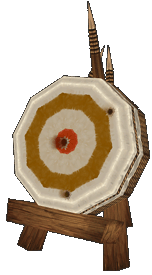


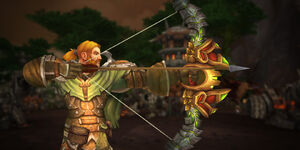

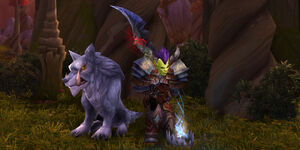







![Hemet Nesingwary, with [Nesingwary 4000] equipped.](https://static.wikia.nocookie.net/wowpedia/images/f/f8/Hemet_Nesingwary_Wallpaper.jpg/revision/latest/scale-to-width-down/107?cb=20180120005234)




